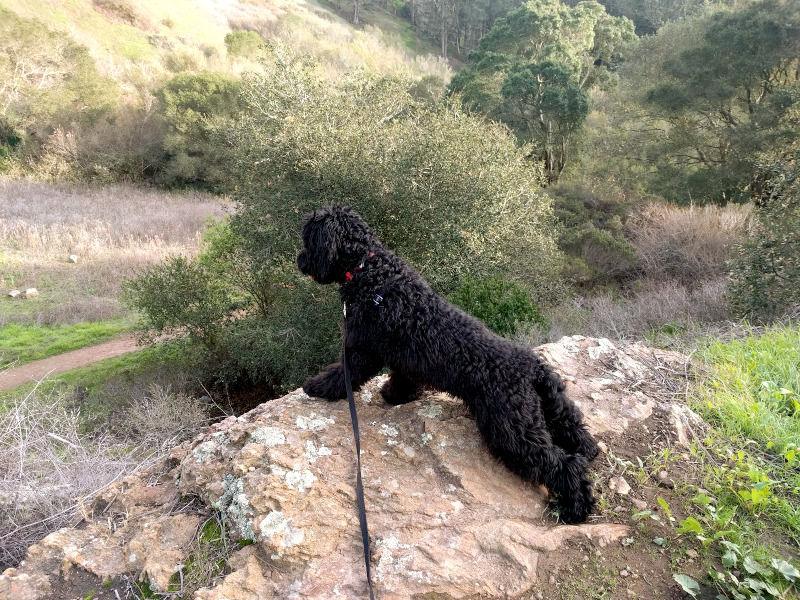Whose Walk is it Anyway? Why Stopping to Sniff Matters

For most dog owners, the main purpose of a dog walk is for their pup to potty and get some exercise. For dogs, though, the most exciting parts of any excursion are the smells.
Dog owners frequently complain that their dog pauses to sniff too often or pulls when they want to investigate something. Humans tend to go from one place to another in a straight line without too much stopping. Dogs want to meander and pause at each new aroma. This mismatch of expectations can often lead to frustration on both ends of the leash.
Dogs experience the world through scent, and their nose is the primary way they get information about the world around them. Their noses have 300 million olfactory receptors compared to our mere 5 million, and their sense of smell is so keen that they can detect scent molecules in parts per billion. In fact, dogs can detect odors better than any of our current electronic or digital sensors. Watch this short video to geek out more about the canine olfactory system.
Dogs seek out scents similar to the way humans are drawn to color. We enjoy gazing at different colors in art and sunsets and landscapes. We delight in colorful patterns and adorn our bodies with various hues and tints. People rarely describe colors as disgusting or repulsive.
I suspect this is how dogs experience smells. All the smells are interesting to them. A pungent dead animal or a dirty diaper is as marvelous to them as a canyon vista or a Rembrandt is to us. Expecting your dog to enjoy a walk without sniffing is akin to you wearing blinders at a museum. While riding a bicycle.
Naturally, not every outing needs to be devoted to sniffing. Sometimes we do need to get from point A to B and can't stop every few feet. Learning to walk by your side on a loose leash is a necessary skill, but it’s not one that comes naturally to dogs. Walking on lead without pulling requires dedicated and consistent training, and that’s your job as a human. Of course, you could always keep your dog in a heel and never allow them to stop for a sniff, but why would you? Whose walk is it anyway?
Sniffing and allowing yourself to be sniffed is a big part of the canine greeting ritual. Leashes - especially short leashes - can interfere with this delicate dance. Leash greetings can quickly become fraught because neither dog can move away if they feel uncomfortable. In addition, the leash impedes necessary body language and sniffing behavior that lubricates social interaction. Butt and groin sniffing is normal, species-appropriate behavior. There is no need to feel embarrassed about where your dog sticks their snout.
Humans typically greet each other face-to-face with direct eye contact and an outstretched hand. In the dog world, approaching head-on with eye contact is a provocation. So when greeting a new dog, stand at an angle and wait for them to initiate contact. Offering your hand for a sniff is unnecessary: dogs can sniff out drugs, bombs, cancer, and Covid. They don't need you to stick your hand in their face to get a good whiff.
We always suspected that sniffing made dogs feel better, but a French field study actually found that sniffing lowers your dog's pulse rate, and that the "higher the sniffing intensity, the more the pulse will lower." In this study, the longer the leash, the more sniffing occurred. Unleashed dogs spent 330% more time sniffing than dogs on short leads.
If you are struggling with a reactive, hyper-vigilant, or over-aroused dog when outside, find time to take them on what dog trainer and podcaster Sarah Stremming calls "decompression walks ." Find a quiet place in a park with as few distractions as possible, put your dog on a long loose lead (at least 6 feet long but ideally 15 feet), and let them sniff. It may take a while to settle into this new outside activity. You can encourage sniffing by scattering treats or kibble on the ground and letting them search for it. If possible, allow your dog to choose the route of their sniffing safari rather than leading them around by the leash.
Bottom line: your dog has an innate need to sniff. Rushing your dog's walks and pulling them away from smells is no fun for anyone. Yes, it may require more time and patience on your walks. But if you didn't have a dog, you’d probably be at home watching Netflix, so really what are you saving yourself for?
In the end, it's their walk. Let them enjoy it the way they’re meant to.

